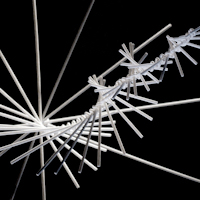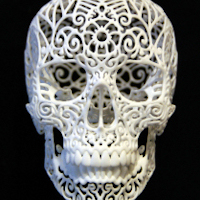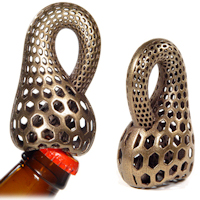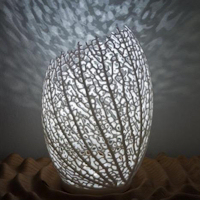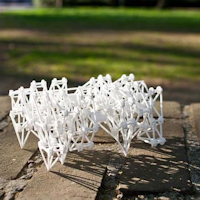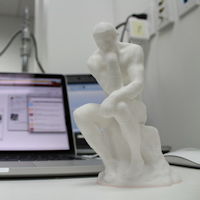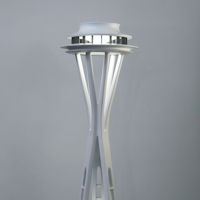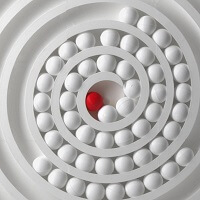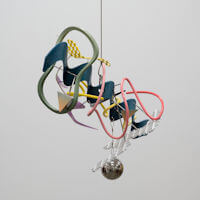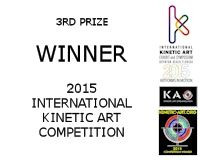3D Printing Artists
Additive manufacturing or 3D printing is a process of making a three-dimensional solid object of virtually any shape from a digital model. 3D printing is achieved using an additive process, where successive layers of material are laid down in different shapes. More and more artists and specifically sculptors are making use of this technology. This is a list of 3D printing artists that I will keep adding to:
Marco Mahler and Henry Segerman
A collection of 3D printed mobiles, the result of a collaboration between Marco Mahler, a kinetic sculptor specializing in mobiles, and Henry Segerman, a research fellow in the Department of Mathematics and Statistics at the University of Melbourne. Designed in the spring of 2013, they appear to be the first fully 3d printed mobiles in the world.
Joshua Harker is a well-known American artist and considered a pioneer & visionary in 3D printed art & sculptures. His sculpture Crania Anatomica Filigre holds the record for the most-funded kickstarter sculpture project. His work is among nearly 3000 collections that include work from notable artists such as Andy Warhol, Ron English, Shepard Fairey, R. Crumb, & Robert Williams.
Bathsheba Grossman is an artist from Santa Cruz, California who creates sculptures in bronze and stainless steel. 3D printing is her main medium but she also works with subsurface laser damage in glass. She defines herself as an artist exploring the region between art and mathematics. Her work is about life in three dimensions: working with symmetry and balance, getting from the origin to infinity, and always finding beauty in geometry.
Nervous System is a generative design studio that works at the intersection of science, art, and technology. We create using a novel process that employs computer simulation to generate designs and digital fabrication to realize products. Drawing inspiration from natural phenomena, we write computer programs based on processes and patterns found in nature and use those programs to create unique and affordable art, jewelry, and housewares.
Theo Jansen is a Dutch kinetic artist. In 1990, he began what he is known for today: building large mechanisms out of PVC that are able to move on their own, known as Strandbeest, wind-walking examples of artificial life. The 3d printed versions of the kinetic sculptures are a great example of what 3D printing is ultimately capable of, and continue to evolve with the addition of a Propeller Propulsion system.
Cosmo Wenman has a vision of digitally scanning masterpieces from museums all over the world, and making the resulting files and information freely available online. His goal is to allow anybody with a 3D printer to be able to reproduce these rare works of art in their own homes, or in the classroom. In fact, he already has several works of art that he has scanned available.
Studio Nick Ervinck applies tools and techniques from new media in order to explore the aesthetic potential of sculpture, 3D print installations, architecture and design. Through his divergent practice, a strong fascination with the construction of space is noticeable. Not only does Nick focus on the autonomous sculptural object, he also questions its spatial positioning and points to the phenomenological experience and embodiment of space.
Linlin (from China) and Pierre-Yves (of French origin) are young artists who were able to blend their cultural differences and artistic skills to make create a partnership of unexpected creativity. These artists met many years ago during their art studies – she brought a master’s degree in digital design and he, a diploma in 3D video production. The chemistry between these two artists was immediate, creating works that are a tribute to nature, knowledge and human feelings.
Monika Horčicová is one of the hottest emerging artists in the Czech Republic. Born in Prague, she currently resides in Brno where she studies at the Faculty of Fine Arts at Brno University of Technology under the tutelage of Prof. Michal Gabriel. Her work explore themes of infinity; a repeated cycle of conception and death. Rather than looking at bones as a symbol of morbidity, she aims to show them as objects that can be beautiful when we view them properly.
Michaella Janse van Vuuren is a designer and artist with a PhD in Electrical Engineering. These diverse interests enable her to create sculptures that are technically complex and artistically competent, with a strong focus on design for 3D printing or additive manufacturing. She writes: “I love the challenge of creating something that is imagined and then designed on computer and seeing if my idea printed out as envisioned. The first time I hold the design in my hand is when the finished product comes out of the 3D printer.”
Louis Pratt’s approach to sculpture is novel and ground breaking. He starts by 3D scanning forms (people) from the real world into the digital world. With these digitized forms he then uses digital sculpture tools to manipulate the scanned data. He explores many types of algorithms and applies them to sculpture.The data is then rapid prototyped back from cyber space into the real world.
Isaïe Bloch, founder of Ergatory, focuses his ongoing research and design ambitions on the correlation between craftsmanship and additive manufacturing within several creative domains including architecture, fashion and plastic arts. He has won the ‘Artist of the Year Award’ at the 2013 3D Printshow in London.
Gilles Azzaro, a French digital artist exposed his latest work at the 3D Printshow in London this year. The voice sculpture print: Barack Obama – Next Industrial Revolution. The 3D printed sculpture is the three-dimensional materialization of President Obama’s voice-print. The 3D voice-print portrays an extract of President Obama’s February 2013 State of the Union Address.
UK designer Lionel Theodore Dean believes in complexity. His objects are defiantly non-square, often pushing the boundaries of the functional object categories all industrial design adheres. Working with rapid prototyping techniques like laser sintering as a designer-in-residence at the University of Huddersfield, Dean realized that these methods were fully capable of producing high-quality objects fit for the consumer market.
Lumenique, the art and design studio of Kevin Lee Willmorth, designs and creates sculptural portable lighting, with designs inspired by architecture and machinery, which includes lighted objects using 3D printing exclusively. In 2010, Kevin created 53 unique functioning SSL products in 52 weeks as an exercise in the creative use of technology. You can also find out more about his process on his blog.
Ivo Meier creates digital art that goes beyond traditional art. He uses digital technologies, namely 3D printing since 2017 to make interactive sculptures that exist in both real and virtual worlds. He combines art and technology in a unique and creative way that engages and inspires the viewer. His art is not only aesthetic, but also meaningful and value-driven. He explores themes of human existence, freedom, purpose, and transformation. He is an artist who pushes the limits of the digital art field and reveals new opportunities.
Trained as an architect and followed by a career in design and fabrication, Sam Wood Wilson uses technology and architectural tools to create assemblages that reconfigure aesthetics and formal tropes from global art and design trends into new worlds and ideas. By sculpting his reaction to the relationship of designed content, contemporary aesthetic, and technology, he creates a narrative that conveys a world between the physical and digital, creating an opportunity for reflection on our ever changing societal structures.
I’ll be adding to this list over time …
If you’re a 3D print artist and would like to be added to this list, please contact me.

